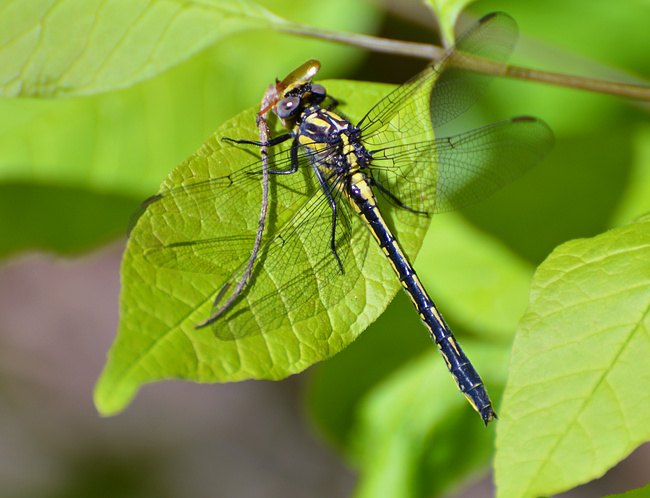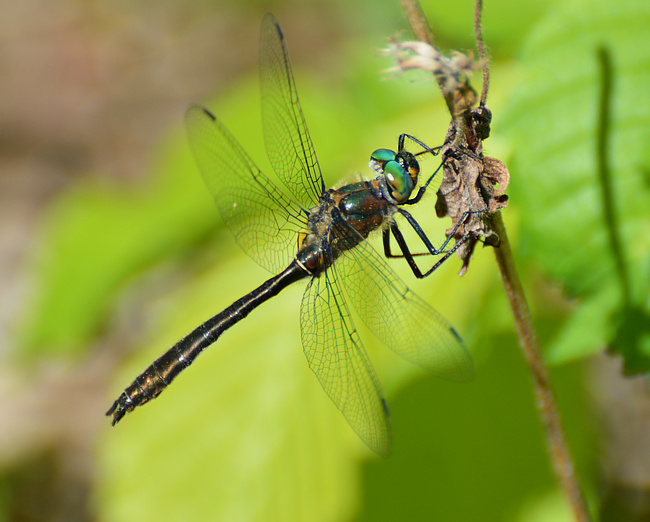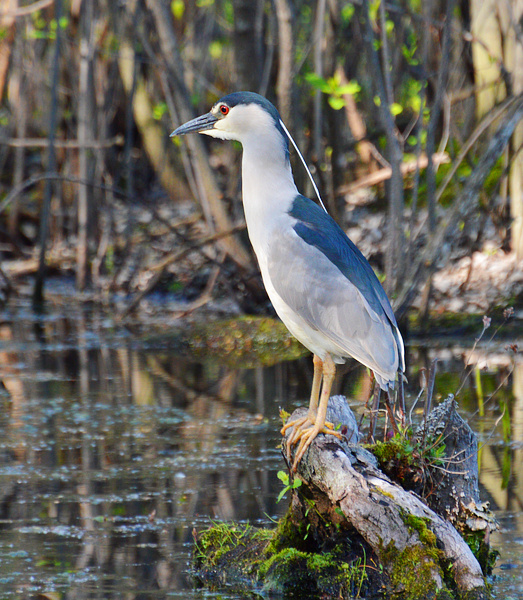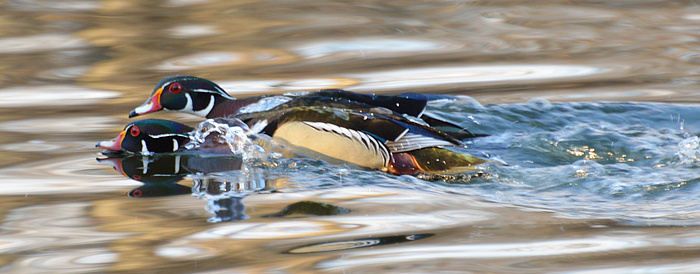
Mud Lake, late spring
May 27th, 2015
Summer is moving in. You can see the progression on the latest page of my gallery: brown and silver bokehs predominating at the bottom, and at the top, green, green, and more green!
Mud Lake's Yellow Warblers are back:

1680x1050 wallpaper

1680x1050 wallpaper
The Black-Crowned Night Herons at Mud Lake seem tamer than in years past, for some reason. It used to be I could only get good pictures of the (stripy brown) teenagers--adults would flush at the slightest disturbance. But I was in clear view of this one and he paid me little mind. Mature Night Herons, seen close up and in good light, are magnificent birds in my opinion!

Lily-of-the-valley, a garden flower that sometimes escapes into woodlands.
Dragonflies and Wildflowers at Sugarbush Trail
May 23rd, 2015
I took my mother to Sugarbush Trail in the Gatineau last week, expecting a nice walk and maybe an interesting bird or two. But despite it being a fairly cool, breezy day, it turned out to be dragonfly heaven! While Chelsea Creek was virtually deserted of odes, sunny, sheltered spots in the woods were teeming with them. And it wasn't the usual "ten bazillion Four-Spotted Skimmers" that you expect to see in spring--these were, at least for me (a perennial dragonfly novice), exotic types that I had never seen before.
Most of them I couldn't identify down to species. But there are whole genera of dragonflies that I'm largely unfamiliar with, and these were they. Baskettails, for instance:

1680x1050 wallpaper
And clubtails:

Chris Traynor, a well-known local naturalist, went to Sugarbush Trail recently himself (perhaps inspired by my post on Facebook) and saw a Moustached Clubtail, and he thinks my photo may be of the same species. If so it's a rarity in this region.
I have no idea what it's dining on here--please comment if you do! So far the best guess I or anyone has come up with is that it's eating a shrivelled-up fellow dragonfly.

American Emerald. Nothing exotic about this one, but it is beautiful. Emeralds are called that because of the color of their eyes. I think they should be called Opals instead.
The woods were full of trillium, and I searched for those elusive "pink" trilliums--white ones that have turned to pink but not yet wilted beyond the point of photogenic. My mom pointed out this one, and it ended up being the best of the lot.
 <
<
More exciting was our discovery of a red (a.k.a. purple) trillium. This is a separate species, and one I've rarely seen. In fact I think this is the first time I've found a red trillium in full bloom. There were more along the trail, but they were all wilted already.

I tested the claim that red trillium is ill-scented. The claim is true! They pollinate themselves with the help of flies, and attract the flies by smelling like carrion. The liver-red color of the flower is also part of that subterfuge.
Three Hunters
May 13th, 2015
My mother is visiting from Virginia. I took her to Mud Lake this afternoon, and Mud Lake brought out all its charms for her! It was the birdiest I'd seen it (or heard it) this spring. Near the trailhead were two surprisingly tame adult Night Herons, one of them actively fishing.
The action was so good I had to go back home, get my camera, and come back. Fortunately one of the Night Herons waited for me.

1680x1050 wallpaper
Down the trail, the Eastern Screech-Owl was out of his hole. (I've decided to give up trying to keep this secret, since it's very much an open secret, and really, the owl doesn't seem to care the darndest about people watching him.) He was perched low down and close to the trunk of an old snag. From a distance, he did a convincing imitation of a broken off branch:


While the bunch of us (my mom and I and other photographers) were watching the owl, a Cooper's Hawk got into a noisy fight with a couple of crows, which ended badly (though not fatally) for one of the crows! Most of us went over to photograph the hawk, perched low after the altercation and looking completely unruffled.

When we got back, my mom regaled us all with how the fight had woken the owl up, and how it had its eyes wide open, looking all around. We got back just in time to see it falling back to sleep.

1680x1050 wallpaper
Shine For A Day
May 11th, 2015
South March Forest has dense carpets of trout lilies right now--most of them peaked and wilted, and soon to disappear. But this one was still perfect.

1680x1050 wallpaper
Spring Beauty
May 9th, 2015
An early-blooming, ephemeral wildflower. It disappears once the trees above it have leafed out.

1680x1050 wallpaper
In Praise Of Common Birds
May 4th, 2015
It's a good time of year to appreciate the beauty of common birds at their breeding peak. This mallard was looking particularly gorgeous in the late afternoon light.

1680x1050 wallpaper
Ring-Billed Gulls are one of those birds where familiarity breeds contempt, and I'm sure most birders seldom bother to train their binoculars on one. They're actually quite striking in breeding plumage. Their gapes and eye rings become such a brilliant shade of orangey-red, it looks fluorescent to me. When a Ring-Billed Gull calls on territory, he's not just declaring himself by sound, he's also flashing that gape the way a Red-Winged Blackbird flashes his epaulets.

1680x1050 wallpaper
Closeup:

Sunset Wood Ducks
April 30th, 2015
Testosterone fever at Mud Lake yesterday evening, with drake mallards and drake wood ducks putting on a show. Actually most of the ducks are paired up already, but that's not stopping hopeful third parties doing their best to wedge themselves in! At one point, a pair of male mallards swam around a lone female, bills raised, going "quack. quack. quack." with the most exquisite air of self-importance. It was enough that I and the photographer next to me, formerly too engrossed in our work to pay much attention to each other, had to look at each other and laugh.
People feed the ducks at the north shore, to draw them closer in. I have mixed feelings about it--on the one hand I prefer seeing birds wild, but on the other hand, the photographer in me loves it! (Also on the other hand, it's been a hard, slow spring, and I'm sure they need all the extra food they can get.) You need only kneel down on the rocks, and soon the throng approaches in anticipation of cracked corn. If you don't feed them, they go back to their business, but stay close for awhile just in case, making for some nice photo ops as the drakes pose, preen, dabble, and occasionally tear off racing each other across the water.

1680x1050 wallpaper

1680x1050 wallpaper
Crest fully poofed-out. I only ever see them like that in spring.

1680x1050 wallpaper

Sleepy Screech Owl
April 28th, 2015
These little guys can be remarkably well-camouflaged if you don't know to look for them! Eastern Screech-Owls roost and nest in old woodpecker holes. They look very cute and innocent when you catch one by day. By night, they prey on small birds and mammals, and make a sound that raises goosebumps on your skin.

This is an Ottawa-lister for me (i.e. the first time I've found one in Ottawa.) I'd previously seen screech owls a few times on birding trips to Point Pelee.
Here's a higher-res version.
Oil Beetle
April 25th, 2015

I couldn't tell much about this beetle by naked eye. It just looked like it was clambering around in the grass. But it took on a lot more personality under the zoom lens. I have seldom seen a creature eat with as much gusto as it was eating on that grass stalk--you could almost hear the "OM NOM NOM" sounds.
Oil beetles (also called blister beetles) have a fascinating start to life. Once they hatch, the larvae will climb up a flower stalk and gather in a mass that roughly approximates the shape of a bee, while also emitting a fake female-bee-pheromone smell (which species of bee depends on which species of oil beetle.) When a male comes and attempts to mate with this trojan bee, the larvae separate and climb onto him, and then when he finds a real female bee to mate with, climb onto her. They finally end up in the underground nest where she lays her eggs, where they will proceed to eat the honey and pollen she provisioned her young with, and then eat the eggs too.
Spring Display
April 20th, 2015

1680x1050 wallpaper
|
